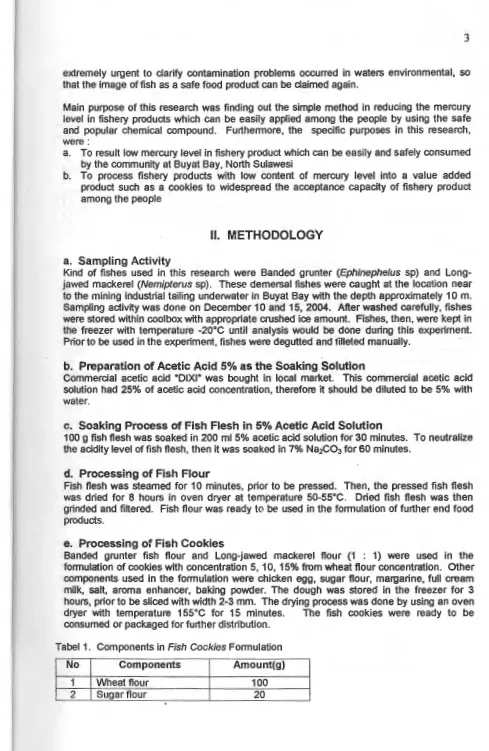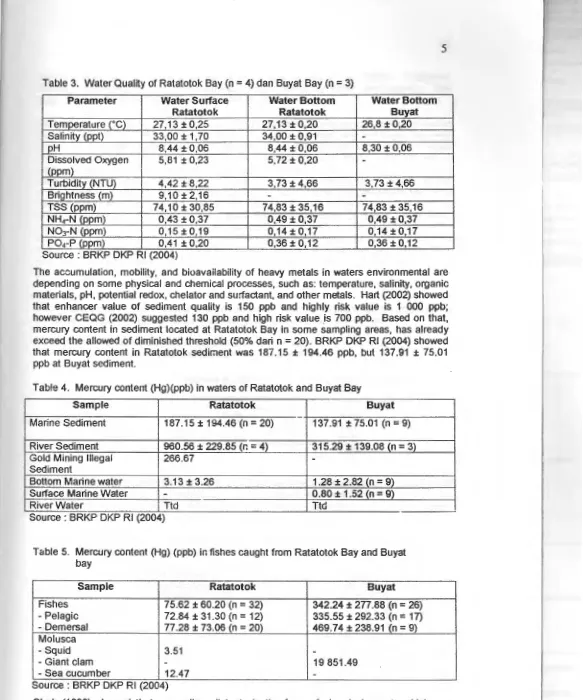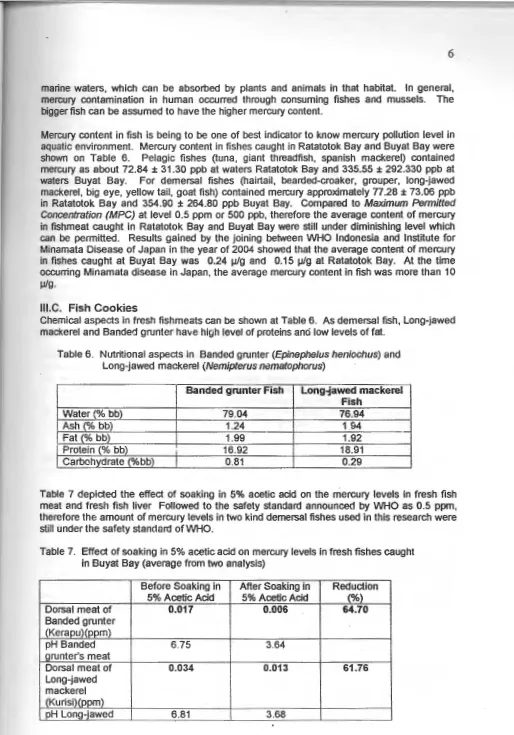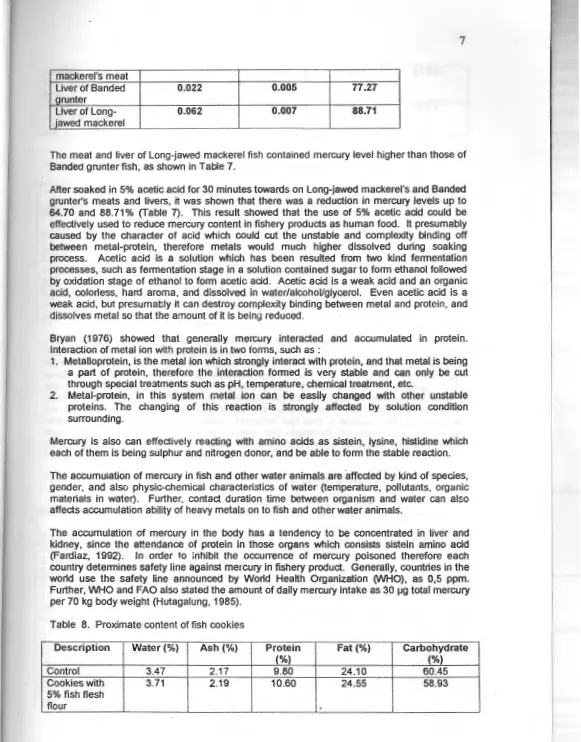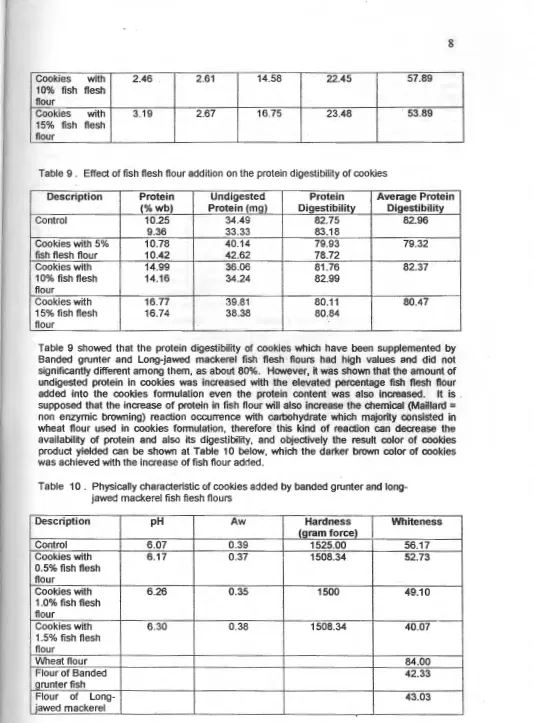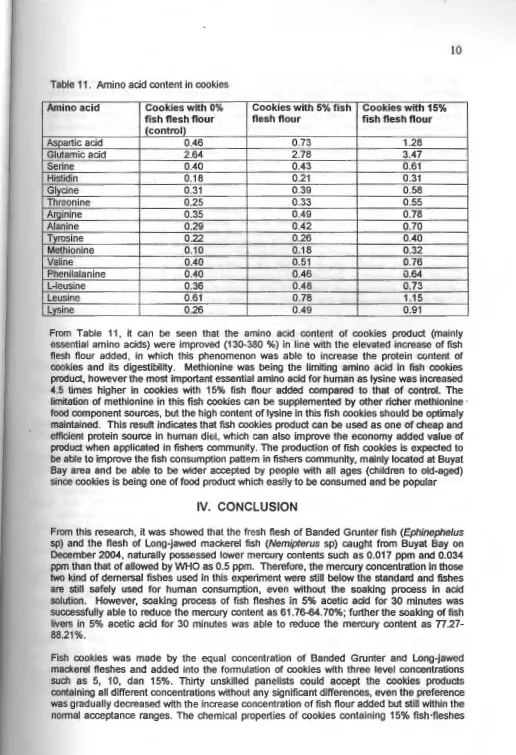IMPROVEMENT AS COOKIES PRODUCT"
Dr. MITA WAHYUNI* and Ora. Pipih Suptijah, MBA
Dept. of Fish Processing Technology, Faculty of Fisheries and Marine Science,
Bogor Agricultural University, IPB Campus Dannaga, BOGOR 16680, INDONESIA,
Tel/Fax: 0251-622916, E-mail: [email protected]
Presented orally in The International Seminar on Mining, Environment, and Sustainable Development :A Lesson from the Gold Mining Controversy in Buyat Bay, North Sulawesi, Indonesia; held
at
Ritzy Hotel, Manado on May 9-10, 2005ABSTRACT
It has been long indicated that the community live along the coastal of Buyat Bay
consume fishery products which contaminated by the attendance of heavy metal
mercury which are being one element of wastes resulted from the mining industry
namely PT NEWMONT M!NAHASA RAYA located near to Buyat Bay. It is known
that mercury is a harsh chemical compound which can affect on the function of
brain system, skin irritation, and kidney disfunction. The negative impact comes
from the mercury pollution in marine water, is the increase of unsafe feeling among
the people to consume fishery products; and this is definitely against the national
programs in improving the healthy and quality of people by increasing the fish
consumption. Therefore, it is necessary
to
find out how to provide fish products
located at contaminated waters which can be safely consumed.
The result of this research showed that the fresh flesh of Banded Grunter fish
(Ephinephe/us
sp) and the flesh of Long-jawed mackerel fish
(Nemipterus
sp)
caught from Buyat Bay on December 2004, naturally possessed lower mercury
contents such as 0.017 ppm and 0.034 ppm than that of allowed by WHO as 0.5
ppm. The soaking of fish fleshes in 5% acetic acid for 30 minutes was able to
reduce the mercury content as 61 .76-64.70%; further the soaking of fish livers in
5% acetic acid for 30 minutes was able to reduce the mercury content as
77.27-88.21%.
Fish cookies was made by the equal concentration of Banded Grunter and
Long-jawed mackerel fleshes and added into the fonnulation of cookies with three level
concentrations such as 5, 10, dan 15%. Thirty panelists could accept the cookies
products containing all different concentrations without any significant differences.
The chemical properties of cookies containing 15% fish fleshes are followed : water
3.19%, ash 2.67%, crude protein 16.75%, crude fat 23.48%, and carbohydrate
53.89%; which is 80% higher than that of control cookies. The use of 15% fish in
the fonnulation could increase the amount of essential amino acids as 130-380 %,
mainly for lysine. Protein digestibility of cookies was about 79.32-82.96%, whereas
the increase of fish concentration would also improve the protein digestibility of
protein in cookies products.
I.
INTRODUCTION
Mercury, beside of cadmium and arsenic, has ever been judged to cause some physically and nerve negative symptoms occurred among people live along the coastal of Buyat Bay and consumed fishery products which caught from marine waters surrounding. Some bruises were appeared on the surface of parts of body among the local community, and became as a controversy, they claimed these were caused by consuming water and fishery products naturally produced surrounding.
Naturally, heavy metal is being one of component in land, which can not be degraded or destroyed. This heavy metal is entered into human body through foods, drink water, or even air. Heavy metals can be considered as a dangerous element since its bioaccumulation effect in the body in line with the food pyramidal system; therefore the increase level of heavy metal within environmental will also cause the increase of heavy metal levels in the body which can not be easily extracted or degraded in the body. Mercury can cause the serious effect towards on the healthy quality of human, mainly against nerves system, skin irritation, and kidney dysfunction. The emotional disturbance caused by mercury contamination can also happened, such as high temper, tremor, shiny, disturbances in sight and memory.
In waters, mercury can be easily react with Chloride, which will react to make an inorganic mercury (HgCI). This HgCI is able to easily enter into plankton and move to other marine organisms or consumed by fishes, therefore the mercury level in fish body is high. In food chain, the bigger fish can be predator towards on other smaller fishes. This cause the highest level of mercury is possessed by the highest fish predator, which can accumulate ten folds of mercury content in waters surrounding. In human body, heavy metal will be able to replace other more useful minerals such as: Zn, Cu, Mg, and Ca.
Another more fatal effect caused by the occurrence of contaminated waters and fish products, is the excessive anxiety among the people to consume fishery products. This fact is contradiction witll the national program announced by the Indonesian government in imoroving the healthy and the intelligence of people through increasing fish consumption in dietary pattern. With more than 1.9 ppm content of methyl mercury in fish products will be dangerous to be consumed, especially for children. In Minamata case, the content of methyl mercury in fish reached about 100 ppm. Therefore, it is important for the government to provide information about methyl mercury content in fishery products in all areas; however this is still never being done up to present time.
On the other hand, fish consumption among Indonesian people at current time is still low, maybe the iowest one among Asian countries, as approximately 24,67 kg/cap/yrs; even it is claimed that Indonesia is being the fifth fish producer country in the world. The low behavior in consuming fish among Indonesian people is presumably having a positive correlation with the low level of manpower quality as indicated in Human Development Index (HOI).
In 2002, among 173 countries counted, HOI Indonesia reached 110 (UNDP, 2002); this fact was worse than that of 2001. Among Southeast Asian countries, Indonesia reached the seventh level from 10 countries counted . This condition will, of course, have further worse implication in global competition map in the future.
extremely urgent to clarify contamination problems occurred in waters environmental, so that the image of fish as a safe food product can be claimed again.
Main purpose of this research was finding out the simple method in reducing the mercury level in fishery products which can be easily applied among the people by using the safe and popular chemical compound. Furthermore, the specific purposes in this research , were :
a. To result low mercury level in fishery product which can be easily and safely consumed by the community at Buyat Bay, North Sulawesi
b. To process fishery products with low content of mercury level into a value added product such as a cookies to widespread the acceptance capacity of fishery product among the people
II. METHODOLOGY
a. Sampling Activity
Kind of fishes used in this research were Banded grunter (Ephinephe/us sp) and Long-jawed mackerel (Nemipterus sp) . These demersal fishes were caught at the location near to the mining industrial tailing underwater in Buy at Bay with the depth approximately 10 m. Sampling activity was done on December 10 and 15, 2004. After washed carefully, fishes were stored within coolbox 'tvith appropriate crushed ice amount. Fishes, then , were kept in the freezer with temperature -2ooc until analysis would be done during this experiment. Prior to be used in the experiment, fishes were degutted and t111eted manually.
b. Preparation of Acetic Acid 5% as the Soaking Solution
Commercial acetic acid ·DIXI" was bought in local market. This commercial acetic acid solution had 25% of acetic acid concentration, therefore it should be diluted to be 5% with water.
c. Soaking Process of Fish Flesh in 5% Acetic Acid Solution
100 g fish flesh was soaked in 200 ml 5% acetic acid solution for 30 minutes. To neutralize the acidity level of fish flesh , then it was soaked in 7% Na2C03 for 60 minutes.
d. Processing of Fish Flour
Fish flesh was steamed for 10 minutes, prior to be pressed. Then , the pressed fish flesh was dried for 8 hours in oven dryer at temperature 50-55°C . Dried fish flesh was then grinded and filtered. Fish flour was ready to be used in the formulation of further end food products.
e. Processing of Fish Cookies
Banded grunter fish flour and Long-jawed mackerel flour (1 : 1) were used in the formulation of cookies with concentration 5, 10, 15% from wheat flour concentration. Other components used in the formulation were chicken egg, sugar flour, margarine, full cream milk, salt, aroma enhancer, baking powder. The dough was stored in the freezer for 3 hours, prior to be sliced with width 2-3 mm. The drying process was done by using an oven dryer with temperature 155°C for 15 minutes. The fish cookies were ready to be consumed or packaged for further distribution.
Tabel 1. Components in Fish Cockies Formulation
No Components Amount(g)
1 Wheat flour 100
[image:3.612.53.542.23.774.2]3 Egg 20
4 Margarine 35
5 Full cream milk 2.5
6 Baking powder 0.2
7 Aroma enhancer 1
8 Salt 1
f.
Analysis in Research
Kind of analysis obseNed in this experiment were :
f.1 . Chemically analysis: proximate (AOAC, 1984), total mercury content (AOAC, 1984), protein digestibility (AOAC, 1984), amino acid (AOAC, 1984)
f.2. Physically analysis : pH, Aw, hardness, whiteness
f.3. Consumer preference test : judged by unskilled 30 panelists towards on color, taste, crispiness, performance, flavor cliterions with 7 level hedonic scales
Ill. RESULTS AND DISCUSSION
III.A. Geographical Location
Ratatotok Bay and Buyat Bay locate at southern coast of North Sulawesi, with position 124°41 '24" - 124°44'24" East Longitude dan 0°50'24" - 0°54'00" North Latitude. Administratively, Ratatotok Bay and Buyat Bay involve in East Ratatotok Village, Ratatotok District, South Minahasa Region. Road as the transportation infrastructure has been existed, so that the transportation and communication are being easily occurred; beside of the availability of electricity. There are three piers available for fishing landlng, such as Lakban, Ratatotok, and Bungan. Traditional fishing methods are done by local people in Buyat and Ratatotok Bays.
Ill. B. Fact of Buyat Bay
The width of Ratatotok Bay and Buyat Bay are 2,692 ha and 48,4 ha. Based on Trapezoidal rule, Simpson's rule and Simpson's 3/8 rule approaches used that the volume of each coast is 866.8 juta m3 for Ratatotok Bay and 24.3 juta m3 for Buyat Bay, with flushing time seawater at those Ratatotok Bay and Buyat Bay is 56 times/year or 6.5 days (BRKP DKP Rl (2004)). Flushing time is the average time of the particle to stay in water's body which is identified as the moving effectivity of a pollutant so that the environmental will be cleaned. Table 2 showed the sediment characteristic at Ratatotok Bay and Buyat Bay
Tabel 2. Sediment characteristic at Ratatotok Bay and Buyat Bay
Variable Ratatotok Bay (n
=
11) Buyat Bay (n=
9) Texture-Sand(%) 34,72 ± 26,17
-Ash(%) 59,45 ± 25,22
pH H20 7,81
±
0,19pH KCI 8,18 ± 0,21
Redox - 35 - - 17
Organic Material(%) 2,95 ± 2,24
P04 (ppm) 1 ,01 ± 0,35
P20s (ppm) 0,75 ± 0,26
S04 (ppm) 0,27
±
0,11Fe (ppm) 254,23 ± 395,88 AI (ppm) 45,19 ± 65,86 Source : BRKP DKP Rl (2004)
32,89 ± 26,67 60,00 ± 23,34 7,72 ± 0,35 8,23 ± 0,05 2,54 ± 2,13 1,38
±
0,65 1,03 ± 0,49 0,15 ± 0,07 261 ,92 ± 210,78 [image:4.612.19.580.10.738.2]Table 3. Water Quality of Ratatotok Bay (n
=
4) dan Buyat Bay (n=
3)Parameter Water Surface Water Bottom Water Bottom
Ratatotok Ratatotok Buy at
Temperature COC) 27,13 ± 0,25 27,13 ± 0,20 26,8 ± 0,20 Salinity (ppt) 33,00 + 1,70 34,00 ± 0,91
-pH 8,44 ± 0,06 8,44 ± 0,06 8,30 ± 0,06
Dissolved Oxygen 5,81 ± 0,23 5,72 ± 0,20
-(ppm)Tumidity (NTU) 4,42 ± 8,22 3,73 ±4,66 3,73 ± 4,66
Brightness (m) 9,10 ±2,16
-
-TSS (ppm) 74,10 ±30,85 74,83 ± 35,16 74,83 ± 35,16
NH4-N (ppm) 0,43 ± 0,37 0,49 ± 0,37 0,49 ± 0,37
NO:rN (ppm) 0,15±0,19 0,14±0,17 0,14±0,17
P04-P (ppm) 0,41 ± 0,20 0,36 ± 0,12 0,36 ± 0,12
Source: BRKP DKP Rl (2004)
The accumulation, mobility, and bioavailability of heavy metals in waters environmental are depending on some physical and chemical processes, such as: temperature, salinity, organic materials, pH, potential redox, chelator and su:factant, and other metals. Hart (2002) showed that enhancer value of sediment quality is 150 ppb and highly risk value is 1 000 ppb; however CEQG (2002) suggested 130 ppb and high risk value is 700 ppb. Based on that, mercury content in sediment located at Ratatotok Bay in some sampling areas, has already exceed the allowed of diminished threshold (50% dari n
=
20) . BRKP DKP Rl (2004) showed that mercury content in Ratatotok sediment was 187.15 ± 194.46 ppb, but 137.91 ± 75.01 ppb at Buyat sediment.Tabie 4 . Mercury content (Hg)(ppb) in waters of Ratatotok and Buyat Bay
Sample Ratatotok Buy at
Marine Sediment 187.15 ± 194.46 (n
=
20) 137.91 ± 75.01 (n=
9)River Sediment 960.56 ± 229.85 (r.
=
4) 315.29 ± 139.08 (n=
3)Gold Mining Illegal 266 .67
-Sediment
Bottom Marine water 3.13 ± 3.26 1.28 ± 2.82 (n
=
9)Surface Marine Water
-
0.80 ± 1.52 (n=
9)River Water Ttd Ttd
Source : BRKP DKP Rl (2004)
t・セ「ャ・@ 5. Mercury content (Hg) (ppb) ir. fishes caught from Ratatotok Bay and Buyat bay
Sample Ratatotok Buyat
Fishes 75.62 ± 60.20 (n
=
32) 342.24 ± 277.88 (n=
26) -Pelagic 72.84 ± 31.30 (n=
12) 335.55 ± 292.33 (n=
17) -Demersal 77.28 ± 73 .06 (n=
20) 469.74 ± 238.91 (n=
9) Molusca-Squid 3.51
--Giant clam
-
19 851.49- Sea cucumber 12.47
-Source: BRKP DKP Rl (2004)
[image:5.612.30.613.12.712.2]marine waters, which can be absorbed by plants and animals in that habitat. In general, mercury contamination in human occurred through consuming fishes and mussels. The bigger fish can be assumed to have the higher mercury content.
Mercury content in fish is being to be one of best indicator to know mercury pollution level in aquatic environment. Mercury content in fishes caught in Ratatotok Bay and Buyat Bay were shown on Table 6. Pelagic fishes (tuna , giant threadfish, spanish mackerel) contained mercury as about 72.84 ± 31.30 ppb at waters Ratatotok Bay and 335.55 ± 292.330 ppb at waters Buyat Bay. For demersal fishes (hairtail, bearded-croaker, grouper, long-jawed mackerel, big eye, yellow tail , goat fish) contained mercury approximately 77.28 ± 73.06 ppb in Ratatotok Bay and 354.90 ± 264.80 ppb Buyat Bay. Compared to Maximum Permitted Concentration (MPC) at level 0.5 ppm or 500 ppb, therefore the average content of mercury in fishmeat caught in Ratatotok Bay and Buyat Bay were still under diminishing level which can be permitted . Results gained by the joining between WHO Indonesia and Institute for Minamata Disease of Japan in the year of 2004 showed that the average content of mercury in fishes caught at Buyat Bay was 0.24 IJ/g and 0.15 IJ/g at Ratatotok Bay. At the time occurring Minamata disease in Japan, the average mercury content in fish was more than 10 IJ/g.
III.C. Fish Cookies
Chemical aspects in fresh fishmeats can be shown at Table 6. As demersal fish, Long-jawed mackerel and Banded grunter have high level of proteins and low levels of fat.
Table 6 . Nutritional aspects in Banded grunter (Epinephe/us heniochus) and Long-jawed mackerel (Nemipterus nematoplwrus)
Banded grunter Fish Long-jawed mackerel Fish
Water(% bb) 79.04 76.94
I
Ash(% bb) 1.24 1 .94Fat(% bb) 1.99 1.92
I Protein (% bb) 16.92 18.91
Carbohydrate (%bb) 0.81 0.29
Table 7 depicted the effect of soaking in 5% acetic acid on the mercury levels in fresh fish meat and fresh fish liver Followed to the safety standard announced by WHO as 0.5 ppm, therefore the amount of mercury levels in two kind demersal fishes used in this research were still under the safety standard of WHO.
Table 7. Effect of soaking in 5% acetic acid on mercury levels in fresh fishes caught in Buyat Bay (average from two analysis)
Before Soaking in After Soaking in Reduction 5% Acetic Acid 5% Acetic Acid (%)
Dorsal meat of 0.017 0.006 64.70
Banded grunter (Kerapu)(ppm)
pH Banded 6.75 3.64
grunter's meat
Dorsal meat of 0.034 0.013 61.76
Long-jawed mackerel (Kurisi)(ppm)
[image:6.612.36.550.0.735.2]mackerel's meat
Liver of Banded 0.022 0.005 77.27
grunter
Liver of Long- 0.062 0.007 88.71
jawed mackerel
The meat and fiver of Long-jawed mackerel fish conta ined mercury level higher than those of Banded grunter fish, as shown in Table 7.
After soaked in 5% acetic acid for 30 minutes towards on Long-jawed mackerel's and Banded grunter's meats and livers, it was shown that there was a reduction in mercury levels up to 64.70 and 88 .71% (Table 7). This result showed that the use of 5% acetic acid could be effectively used to reduce mercury content in fishery products as human food. It presumably caused by the character of acid which could
cut
the unstable and complexity binding off between metal-protein, therefore metals would much higher dissolved during soaking process. Acetic acid is a solution which has been resulted from two kind fermentation processes, such as fermentation stage in a solution contained sugar to form ethanol followed by oxidation stage of ethanol to form acetic acid. Acetic acid is a weak acid and an organic acid, colorless, hard aroma, and dissolved in water/alcohol/glycerol. Even acetic acid is a weak acid, but presumably it can destroy complexity binding between metal and protein , and dissolves metal so that the amount of it is being reduced .Bryan (1976) showed that generally mercury interacted and accumulated in protein. Interaction of metal ion with protein is in two forms, such as :
1. Metalloprotein, is the metal ion which strongly interact with protein, and that metal is being a part of protein, therefore the interaction formed is very stable and can only be cut through special treatments such as pH, temperature, chemical treatment, etc.
2. Metal-protein, in this system metal ion can be easily changed with other unstable proteins. The changing of this reaction is strongly affected by solution condition surrounding.
Mercury is also can effectively reacting with amino acids as sistein, lysine, histidine which each of them is being sulphur and nitrogen donor, and be able to form the stable reaction.
The accumuiation of mercury in fish and other water animals are affected by kind of species, gender, and also physic-chemical characteristics of water (temperature, pollutants, orge:mic materials in water). Further, contact duration time between organism and water can also affects accumulation ability of heavy metals on to fish and other water animals.
The accumulation of mercury in the body has a tendency to be concentrated in liver and kidney, since the attendance of protein in those organs which consists sistein amino acid (Fardiaz, 1992). In order to ;nhibit the occurrence of mercury poisoned therefore each country determines safety line against mercury in fishery product. Generally, countries in the world use the safety line announced by World Health Organization (WHO), as 0,5 ppm. Further, WHO and FAO also stated the amount of daily mercury intake as 30 J,Jg total mercury per 70 kg body weight (Hutagalung, 1985).
Table 8. Proximate content offish cookies
Description Water(%) Ash(%) Protein Fat(%) Carbohydrate
(%) (%)
Control 3.47 2.17 9.80 24.10 60.45
Cookies with 3.71 2.19 10.60 24.55 58 .93
[image:7.612.32.613.19.761.2]Cookies with 2 .46 2.61 14.58 22.45 57.89 10% fish flesh
flour
Cookies with 3 .19 2.67 16.75 23.48 - 53.89
15% fish flesh flour
Table 9 . Effect of fish flesh flour addition on the protein digestibility of cookies
Description Protein Undigested Protein Average Protein (%wb) Protein (mg) Digestibility Digestibility
Control 10.25 34.49 82.75 82.96
9.36 33.33 83.18
Cookies with 5% 10.78 40.14 79.93 79.32
fish flesh flour 10.42 42.62 78.72
Cookies with 14.99 36 .06 81.76 82.37
1 0% fish flesh 14.16 34 .24 82.99
flour
Cookies with 16.77 39 .81 80.11 80.47
15% fish flesh 16.74 38 .38 80.84
flour
Table 9 showed that the protein digestibility of cookies which have been supplemented by Banded grunter and Long-jawed mackerel fish flesh flours had high values and did not significantly different among them, as about 80%. However, it was shown that the amount of undigested protein in cookies was increased with the elevated percentage fish flesh flour added into the cookies formulation even the protein content was also increased. It is , supposed that the increase of protein in fish flour will also increase the chemical (Maillard
=
non enzymic browning) reaction occurrence with carbohydrate which majority consisted in wheat flour used in cookies formulat!on, therefore this kind of reaction can decrease the availability of protein and also its digestibility, and objectively the result color of cookies product yielded can be shown at Table 10 below, which the darker brown color of cookies was achieved with the increase of fish flour ad<1ed .Table 10 . Physically characteristic of cookies added by banded grunter and long-jawed mackerel fish flesh flours
Description pH Aw Hardness Whiteness
(gram force)
Control 6.07 0.39 1525.00 56.17
Cookies with 6.17 0.37 1508.34 52.73
0.5% fish flesh flour
Cookies with 6.26 0.35 1500 49.10
1.0% fish flesh flour
Cookies with 6.30 0 .38 1508.34 40.07
1.5% fish flesh flour
Wheat flour 84.00
Flour of Banded 42.33
grunter fish
Flour of Long- 43.03
[image:8.612.39.573.13.736.2]In this experiment was also done organoleptic test to know the cookies formulation which could be accepted by unskilled 30 consumers. The results of organoleptic test can be seen at Figure 1 up to 5 below. From those Figures, it can be seen that in all criterions (appearance, taste, aroma, color, texture), that the consumer preferences on fish cookies products were gradually decreased even not significantly different. However, all consumer preferences were all still above the neutral hedonic scale (4) . The showing hedonic scales indicated that the higher scale tends to the more likely towards on the product given to the consumer.
Figure 1. Hedonic test: Appearance Figure 2. Hedonic test: Color
Figure 3. Hedonic test: Texture Figure 4. Hedonictest: Aroma
[image:9.612.20.591.7.726.2]Table 11. Amino acid content in cookies
Amino acid Cookies with 0% Cookies with 5% fish Cookies with 15% fish flesh flour flesh flour fish flesh flour (control)
Aspartic acid 0.46 0.73 1.28
Glutamic acid 2.64 2.78 3.47
Serine 0.40 0.43 0.61
Histidin 0.18 0.21 0.31
Glycine 0.31 0.39 0.58
Threonine 0.25 0.33 0.55
Arginine 0.35 0.49 0.78
Alanine 0.29 0 .42 0.70
Tyrosine 0.22 0.26 0.40
Methionine 0.10 0.18 0.32
Valine 0.40 0.51 0.76
Phenilalanine 0.40 0.46 0.64
L-leusine 0.36 0.48 0.73
Leusine 0.61 0.78 1.15
Lysine 0.26 0 .49 0.91
From Table 11 , it can be seen that the amino acid content of cookies product (mainly essential amino acids) were improved (130-380 %) in line with the elevated increase of fish flesh flour added, in which this phenomenon was able to increase the protein content of cookies and its digestibility. Methionine was being the limiting amino acid in fish cookies product, however the most important essential amino acid for human as lysine was increased 4.5 times higher in cookies with 15% fish flour added compared to that of control. The limitation of methionine in this fish cookies can be supplemented by other richer methionine , food component sources, but the high content of lysine in this fish cookies should be optimaly maintained. This result indicates that fiSh cookies product can be used as one of cheap and efficient protein source in human di6t, which can also improve the economy added value of product when applicated in fishers community. The production of fish cookies is expected to be able to improve the fish consumption pattern in fishers community, mainly located at Buyat Bay area and be able to be wider accepted by people with all ages (children to old-aged) since cookies is being one of food product which easily to be consumed and be popular
IV. CONCLUSION
From this research, it was showed that the fresh flesh of Banded Grunter fish (Ephinephe/us sp) and the flesh of long-jawed mackerel fish (Nemipterus sp) caught from Buyat Bay on December 2004, naturally possessed lower mercury contents such as 0.017 ppm and 0.034
ppm than that of allowed by WHO as 0.5 ppm. Therefore, the mercury concentration in those two kind of demersal fishes used in this experiment were still below the standard and fishes are still safely used for human consumption, even without the soaking process in acid solution. However, soaking process of fish fleshes in 5% acetic acid for 30 minutes was successfully able to reduce the mercury content as 61.76-64.70%; further the soaking of fish livers in 5% acetic acid for 30 minutes was able to reduce the mercury content as 77.27-88.21%.
[image:10.612.44.560.12.767.2]in the fonnulation could increase the amount of essential amino acids as 130-380 %, mainly for lysine. Protein digestibility of cookies was about 79.32-82.96%, whereas the increase of fish concentration would also improve the protein digestibility of protein in cookies products. Therefore the making of fish cookies is assumed being able to improve fish consumption pattern among community mainly in Buyat bay area, since the simplicity method used, well-known product, long storage time, improved economically added value, creating new income · generating activity, and high protein quality.
ACKNOWLEDGEMENT : This research was fully financially supported by Project of Human Resources Quality Development, Director General of Highly Education, The Ministry of Education Republic of Indonesia (No. Contract: 13/Contract/BPKK-SDM/XI/2004, on December 13, 2004). We also thanked deeply to Mr Fredy, Mr Ferry Kokali, and Mr Adi Firmansyah, Ms. Meity (Head of North Sulawesi Centre for Fishery Quality Control), Mr. Santoso, M.Phil (Head of National Centre for Fishery Quality Control and Processing Technology Development), Mr. Setia Mangunsong, MM (Director of Directorate of Fishery Quality Control and Processing Technology), and Mr. Husni Manggabarani, MS (Director General of Capture Fisheries) in The Ministry of Fishery and Marine Affairs, Republic of Indonesia for all of their kind assistances.
V. LITERATURE CITED
CEOG. 2002. Summary of Existing Canadian Environmental Quality Guidelines. www.ccrnecalinitiativeslwater.water.html?category_id=41 (11-8-2004).
Dahuri, R. 2004. Actual Government Policy in Responsible Fishery management In Seminar of New Paradigm in Responsible Fishery Management in Creating Sustainable Resources and Maximum Economy Usage. Aryaduta Hotel, Jakarta
Darmono. 1995. Heavy Metal in Biological System in Living Organism. Ul Press, Jakarta. Departemen Kelautan dan Perikanan. 2004. Coordination Meeting Materials on 18 Agustus
2004 in Ratatotok Bay and Buyat Bay Environmental Condition
Fardiaz, S. 1992. Water and Air Polutions. Pusat Antar Universitas Pangan dan Gizi, IPB. Hart, B.T. 2002. Water quality guideline. In: Burden, F.R., McKelvie, I. Forstner, U. and
Guenther, A (Eds.). 2002. Environmental Monitoring Handbook. McGraw-Hill Handbooks .
. Heath, A.G. 1987. Water Poliution and Fish Physiology. CRC Press, Inc. Boca Raton, Ann Arbor, Boston.
Hutagalung, H.P. 1985. Heavy Metal in Marine Environmental. Pewarta Oseana, Vol. IX No 1. LON-LIPI. Jakarta
lrwansyah. 1995. Effectivity of Chitin as Residue Mercury Absorben in Green Mussel Thesis. Dept. of Fish Processing Technology, Faculty of Fishery, Bogor Agricultural University Laws, E.A. 1981 . Aquatic Pollution. Introductory Text. John Willey and Sons, Inc., New York. Lee, J.H., Choi, D. 2000a. Environmental Management of Mariculture.
www.hku.hk/civil/enhydraulics/pro_11.htm. (November 2002).
Porsepwandi, W. 1998. Effect of Acidic Levels of Soaking Solution on Mercury Concentration and Quality of Green Mussel. Thesis. Dept. of Fish Processing Technology, Faculty of fisheries, Bogor Agricultural University
Purbani, R. 1997. Effect of the Processing of Shark Fin on Its Mercury Content and Nutritional Value. Thesis. Dept. of Fish Processing Technology, Faculty of Fishery, Bogor Agricultural University
Reily, C. 1980. Metal and Contamination of Food. Elsevier Applied Science. London. Soekarto, S.T. 1990. Basic on Controlling and Standardization of Food Quality. PAU Pangan
Sanusi, H.S., H. Hutagalung, dan H. Razak. 1984. Relationship among Age, Mercury Content, and cadmium in Green Mussel Cultivated at Jakarta Bay. Research Report. Dept. of Fishery Management, Faculty of Fishery, Bogor Agricultural University.
Syarifuddin, A.R., A. Rochyadi. 1994. Heavy Metal Level in Marine Water and Sediment at West Lombok. Proceeding Seminar Marine Pollution Controlling, 7-9 Februari 1994, Jakarta. Wahyuni, M. 2004. Reduction of Mercury Content in Green Mussel at Jakarta Bay through Acid
Method and Its Use in Crackers Product. Proceeding National Seminar Agro Marine. Sahid Jaya Hotel, Jakarta.
WHO Indonesia dan Institute for Minamata Disease- Japan. 2004. Final report. Mercury Pollution: Buyat dan Ratatotok Bay at North Sulawesi, Indonesia.
